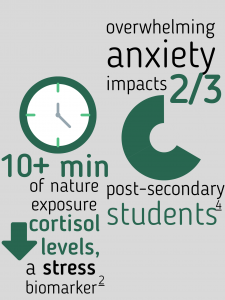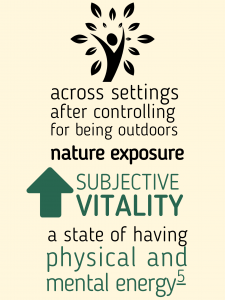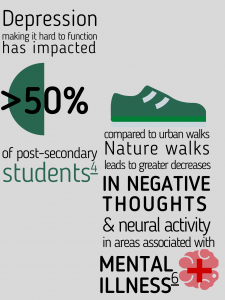Expandable List
Both physical and psychological markers of stress and anxiety have shown  significant reductions following nature exposures. A recent meta-analysis found self-reported stress and anxiety to decrease following exposure to environmental stimuli. Interestingly benefits were experienced both from viewing nature images and engaging in nature walks and gardening1. Salivary cortisol levels, a stress biomarker, have also been shown to decrease significantly following nature exposures2. Studies comparing the effect of levels of nature found that, compared to an urban parks or indoor environments, biometric and psychometric stress markers are significantly reduced following walks in nature settings suggesting that greater nature levels provide further benefits to mental wellbeing above those of outdoor exposure alone3.While the effect increases with greater time of exposure, a study of college students found walking or sitting in natural settings compared urban areas reduced stress significantly in as little as 10 minutes2.
significant reductions following nature exposures. A recent meta-analysis found self-reported stress and anxiety to decrease following exposure to environmental stimuli. Interestingly benefits were experienced both from viewing nature images and engaging in nature walks and gardening1. Salivary cortisol levels, a stress biomarker, have also been shown to decrease significantly following nature exposures2. Studies comparing the effect of levels of nature found that, compared to an urban parks or indoor environments, biometric and psychometric stress markers are significantly reduced following walks in nature settings suggesting that greater nature levels provide further benefits to mental wellbeing above those of outdoor exposure alone3.While the effect increases with greater time of exposure, a study of college students found walking or sitting in natural settings compared urban areas reduced stress significantly in as little as 10 minutes2.
For students, stress and anxiety can be particularly harmful; the National College Health survey found nearly two thirds of post-secondary students reported experiencing overwhelming anxiety in the past 12 months4. By contributing to reduced stress emotionally and physically, spending time in nature can be particularly beneficial in mitigating the burden of anxiety many students experience.
 Spending time in nature can quite literally be revitalizing! Subjective vitality refers to feeling that one has energy both mentally and physically. Taking a break by going outside can be an important part of self-care and actually leave you feeling more awake and energized. A recent study found that being outdoors and in nature leads to a significant increase in feelings of vitality when compared to urban and indoor environments5. After controlling for social and physical activity, the relationship was mediated by the presence of natural elements, things like trees, birds and flowers. While those on outdoor walks in forests and parks typically experienced more natural elements and thus felt more energized, even those in other settings still benefited from elements such as windows, indoor plants and nature images5.
Spending time in nature can quite literally be revitalizing! Subjective vitality refers to feeling that one has energy both mentally and physically. Taking a break by going outside can be an important part of self-care and actually leave you feeling more awake and energized. A recent study found that being outdoors and in nature leads to a significant increase in feelings of vitality when compared to urban and indoor environments5. After controlling for social and physical activity, the relationship was mediated by the presence of natural elements, things like trees, birds and flowers. While those on outdoor walks in forests and parks typically experienced more natural elements and thus felt more energized, even those in other settings still benefited from elements such as windows, indoor plants and nature images5.
 The Canadian National College Health Assessment found over half of university students reporting struggling with depression to a point where it was difficult to function4. Connecting the anxiety reducing and mood boosting impacts, spending time in nature can also contribute to improving mental health, in particular for those experiencing depression. A recent review found that walks in nature help alleviate symptoms of depression, reduce negative thoughts and decrease activation of brain matter associated with mental illness6.
The Canadian National College Health Assessment found over half of university students reporting struggling with depression to a point where it was difficult to function4. Connecting the anxiety reducing and mood boosting impacts, spending time in nature can also contribute to improving mental health, in particular for those experiencing depression. A recent review found that walks in nature help alleviate symptoms of depression, reduce negative thoughts and decrease activation of brain matter associated with mental illness6.
A review of the upstream health promoting impacts of nature found self reported mood shows significant increases following greenspace exposures7. Even looking at images of nature can improve mood and attention while decreasing stress. Interestingly, despite over 90% of Canadian reporting being happier outside, we spend over 94% of our time indoors or in a vehicle with the majority or Canadians spending less than 2 hours outdoors per week8,9.









